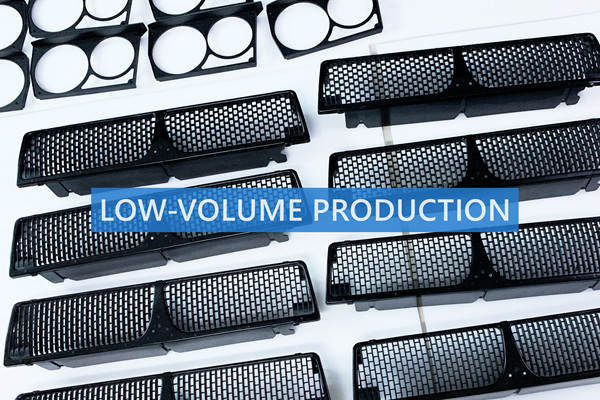What is low volume production?
What does low volume production mean?
Low volume production is the production of saleable or usable parts/products using rapid low volume tooling for injection molding or individual part/product manufacturing techniques such as 3D Printing, CNC Machining, and Vacuum Casting. High-volume injection tools are more expensive and are made from steel molds that can support production in excess of millions of units. Machining durable molds for mass production processes such as injection molding is expensive and can add weeks or months to production time. When a company needs to invest in tool steel, a special type of hardened and very strong steel that needs to make the machines used to make the product, it costs a lot of money to create a mass production run.
Low volume production allows you to test the rapid prototyping of a product at the lowest cost, effectively avoiding the problems that can occur with mass-produced parts. Using processes suitable for small batches, prototypes and production units can have similar components and materials. This production method is typically used to make unique and more complex products with specific quality requirements. Many industries have found that Low volume production allows them to spend less time and money on materials and equipment and get to market faster. In addition, recent advances in additive manufacturing have allowed engineers to create complex parts and unique design features without creating molds, saving cost in many ways. The popularity of additive and subtractive manufacturing, such as 3D printing and CNC machining, has changed the way products are manufactured and lead times. With those manufacturing method, start-up costs are low—less material waste and less labor.
In the small manufacturing industry it is generally impossible to keep production on a scale below a certain quantity, or there is a great difference in price according to quantity. The advantage ofsmall batch production is that it can meet a wide range of needs, increase customer satisfaction, and reduce the risk of stocking spare parts. Low volume production becomes ideal even if a company knows that the design of a part can change and wants to avoid being waste with obsolete inventory created due to minimum order requirements from large manufacturers.
While traditional manufacturing methods such as plastic injection molding may still be the best option when your project requires more parts, low volume production has grown in popularity over the past few years. Numerous manufacturing methods, including vacuum casting and CNC machining, increase the possibility of low-cost low-volume production. At SANWO, we offer low volume production services from single part to large-scale production. We are custom low volume manufacturing supplier from China, trusted advise that CNC machining, 3D printing and vacuum casting are great options.
How much is low volume production?
Low volume production typically refers to manufacturing runs with quantities ranging from tens to hundreds or low thousands of units. The exact cost of low volume production depends on several factors, including:
Complexity of the Product: More intricate designs or products with multiple components may require additional time and resources for manufacturing, thereby increasing costs.
Materials Used: The cost of materials can vary widely depending on their type, quality, and quantity required for production.
Manufacturing Processes: Different manufacturing processes (e.g., injection molding, CNC machining, 3D printing) have varying costs associated with setup, equipment, and labor.
Labor Costs: Labor costs include wages for skilled workers involved in the production process, such as technicians, machine operators, and assemblers.
Tooling and Setup Costs: Initial setup costs, including tooling and equipment setup, may be spread across fewer units in low volume production, increasing the per-unit cost.
Quality Control and Testing: Ensuring product quality through inspection, testing, and quality control measures adds to the overall cost of production.
Supplier Relationships: Utilizing established supplier relationships or outsourcing to specialized manufacturers may affect production costs.
As a ballpark figure, low volume production costs could range from a few hundred to several thousand dollars per unit, depending on the factors mentioned above. It's essential to carefully analyze these factors and obtain quotes from manufacturers to get a more accurate estimation for your specific project.

Who is better suited for low volume production?
The suitability of low volume production depends on various factors such as cost, flexibility, and customization requirements. Here are a few options commonly considered for low volume production:
3D Printing/Additive Manufacturing: Ideal for producing small batches of highly customized or complex parts with relatively low setup costs. It offers design flexibility and quick turnaround times.
CNC Machining: Suitable for low volume production of metal or plastic parts with high precision requirements. Setup costs can be higher compared to 3D printing, but it offers excellent surface finish and material options.
Injection Molding: Typically associated with high volume production, but it can also be used for low volume runs with the help of rapid tooling techniques. Setup costs are high, but unit costs decrease with higher quantities.
Small Batch Manufacturing Facilities: Some manufacturing facilities specialize in low volume production, offering a range of processes like casting, molding, and machining. These facilities often provide more personalized attention and flexibility for small orders.
Digital Manufacturing Platforms: Platforms that connect manufacturers with customers for on-demand production of custom parts or products. These platforms leverage digital technologies to streamline the production process for small batches.
The best option depends on specific requirements such as cost constraints, desired material properties, part complexity, and lead times.
A Good Supplier for Your Low Volume Production
What is an example of low volume production?
Which of the following is a benefit of low volume production?
What is considered low volume production?
What type of manufacturing process may be more suitable for low volume production?
What is the difference between high and low volume production?

